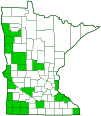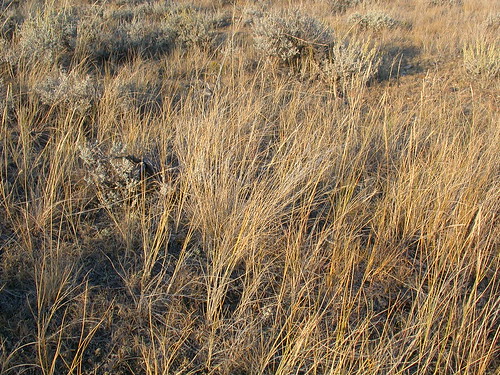red three-awn
(Aristida purpurea var. longiseta)
Conservation • Description • Habitat • Ecology • Use • Distribution • Taxonomy
Conservation Status |
|
|||||||
| IUCN Red List | LC - Least Concern |
|||||||
| NatureServe | NNR - Unranked S3 - Vulnerable |
|||||||
| Minnesota | Special Concern |
|||||||
Description |
||
Red three-awn is a medium-sized, slender, tufted, warm season grass. It occurs in the western half of the United States, in adjacent Canadian provinces, and in northern Mexico. It is uncommon in Minnesota, where it is at the easternmost extent of its range. It is found on dry and moderately dry (mesic) hillsides, open prairies, and rock outcrops. It is also found in disturbed areas, including roadsides, railroads, and abandoned fields. It grows under full sun in dense, often large tufts, in well-drained, fine-textured soils. It is drought tolerant but decreases in periods of extended drought. It is listed as a species of special concern in Minnesota due to habitat loss. Red three-awn has a fibrous root system. It does not form underground horizontal stems (rhizomes). The stems are hollow, hairless, round in cross section, and 4″ to 20″ (10 to 50 cm) tall. They may be erect or curve upward from the base (ascending). They are usually unbranched. The leaves are usually mostly clustered at the base (basal). The base of the leaf that wraps around the stem (sheath) is open and hairless. It does not disintegrate into thread-like fibers at maturity. The blade is grayish-green and linear. It can be 1½″ to 10″ (4 to 25 cm) long but is usually no more than 4″ (10 cm) in length. It may be flat and slightly curved, but it usually rolls inward on top, stands stiffly erect, and appears wiry. When unrolled it is 1⁄32″ to 1⁄16″ (1.0 to 1.5 mm) wide. The tip is sharply pointed. The upper surface is rough. The collar is inconspicuous. It does not have developed shoulders or ear-like projections (auricles). It often has a tuft of long hairs on each side.The ligule is tiny, just 1⁄64″ (0.1 to 0.4 mm) in length. It consists of a fringe of short hairs on a short membranous base. The inflorescence is a narrow, nodding, sparingly branched cluster (panicle) at the end of the culm. The panicle is 2″ to 6″ (5 to 15 cm) long. The branches are short and stout. They are stiff and appressed or curved upward at the base, delicate and drooping at the top. The spikelets are reddish. This is the feature that gives the species its common name. Each spikelet has a single flower, a pair of sterile glumes, and a single fertile lemma. The lower glume is 5⁄16″ to ½″ (8 to 12 mm) long, the upper glume is ⅝″ to 1″ (16 to 25 mm) long. The glumes are translucent and have a short, stiff, bristle-like extension (awn) at the tip. The lemma is ½″ to ⅝″ (12 to 16 mm) long. The lemma has three long awns at the tip. This is the feature that gives the genus its common name. The lemma awns are nearly equal in length. They can be 1″ to 4″ (2.5 to 10 cm) long but are usually 1½″ to 2¾″ (4 to 7 cm) in length. This is the feature that gives the subspecies its scientific name. The awns are reddish, soft, and parallel to the stem at first. As the seed matures, the awns become pale and stiff, and spread widely, eventually at an angle of about 120° to each other. There are usually some spikelets remaining on the plant through the winter. |
||
Height |
||
4″ to 20″ (10 to 50 cm) |
||
Similar Species |
||
Habitat |
||
Dry. Hillsides, open prairies, rock outcrops, roadsides, railroads, and abandoned fields. Full sun. Well-drained, fine-textured soils. |
||
Ecology |
||
Flowering |
||
Mid-June through July |
||
Pests and Diseases |
||
|
||
Toxicity |
||
The sharp awns can cause injury to the eyes, nose, and mouth of livestock |
||
Use |
||
|
||
Distribution |
||||
|
Sources |
|||
| 11/17/2021 | ||||
Nativity |
||||
Native |
||||
Occurrence |
||||
Uncommon in Minnesota |
||||
Taxonomy |
|||
| Kingdom | Plantae (Plants) | ||
| Division | Tracheophyta (Vascular Plants) | ||
| Subdivision | Spermatophytina (Seed Plants) | ||
| Class | Liliopsida (Monocots) | ||
Order |
Poales (grasses, sedges, cattails, and allies) | ||
Family |
Poaceae (grasses) | ||
Subfamily |
Aristidoideae (threeawns and wiregrasses) | ||
Tribe |
Aristideae | ||
Genus |
Aristida (wiregrass) | ||
| Species | Aristida purpurea (purple three-awn) | ||
There are seven recognized varieties of Aristida purpurea. Only var. longiseta occurs in Minnesota. Some authoritative sources, including Plants of the World Online (POWO) and World Flora Online, classify this as the species Aristida longiseta. |
|||
Subordinate Taxa |
|||
|
|||
Synonyms |
|||
Aristida curtiseta Aristida fasciculata var. nuttallii Aristida longiseta Aristida longiseta ssp. rariflora Aristida longiseta var. longiseta Aristida longiseta var. rariflora Aristida longiseta var. robusta Aristida pallens Aristida purpurea ssp. robusta Aristida purpurea var. robusta Aristida rariflora |
|||
Common Names |
|||
dogtown grass Fendler’s threeawn Fendler threeawn red threeawn red three-awn wire grass |
|||
Glossary
Ascending
Growing upward at an angle or curving upward from the base.
Collar
In grasses: The area on the back of a grass leaf at the junction of the sheath and the blade. On moths: the upperside of the prothorax.
Glume
A chaffy, empty, sterile bract at the base of a grass spikelet. Glumes usually occur in pairs, but occasionally only one is present.
Lemma
The outer, lowermost of the pair of bracts at the base of the grass floret; it ensheathes the palea.
Ligule
In grasses and sedges, an outgrowth on the leaf at the junction of the blade and the sheath, usually membranous, sometimes no more than a fringe of hairs. In flowering plants, the ligule is the flat, strap-shaped, petal-like portion of the corolla of a ray floret.
Linear
Long, straight, and narrow, with more or less parallel sides, like a blade of grass.
Panicle
A pyramidal inflorescence with a main stem and branches. Flowers on the lower, longer branches mature earlier than those on the shorter, upper ones.
Rhizome
A horizontal, usually underground stem. It serves as a reproductive structure, producing roots below and shoots above at the nodes.
Sheath
The lower part of the leaf that surrounds the stem.
Visitor Photos |
|||||
Share your photo of this plant. |
|||||
| This button not working for you? Simply email us at info@MinnesotaSeasons.com. Attach one or more photos and, if you like, a caption. |
|||||
Nancy Falkum |
|||||
I am pretty sure this is Three Awn Grass before twisting. We did find some close by that was twisted, the photo did not show clearly. |
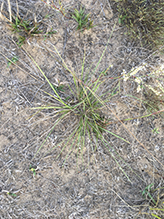 |
||||
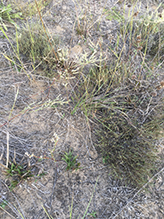 |
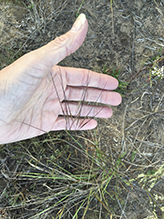 |
||||
MinnesotaSeasons.com Photos |
|||||
|
|||||


Visitor Videos |
|||
Share your video of this plant. |
|||
| This button not working for you? Simply email us at info@MinnesotaSeasons.com. Attach a video, a YouTube link, or a cloud storage link. |
|||
Other Videos |
|||
| Aristida purpurea, (Purple three awn) Grass, graceful, wind dancing. Koby's Garden Alchemy |
|||
About
Oct 20, 2019 This shimmering, purply-rosy display heralds the beginning of warm weather. After sun-bathing for months, it then matures into a veritable blonde beauty. There aren't many grasses that have the sublime tonal transformation of Aristida purpurea, commonly called "Purple three-awn". Aristida purpurea, by many accounts, seems to be a moderate seeder. It could be an alternative or replacement for the more aggressive seeding of "Mexican Feather Grass" / "Argentine needle-grass" - Nassella (Stipa) tenuissima. "Purple three-awn's" sinuous nature sways and sweeps with the breeze. It's vast N. American range, from Canada to Mexico and the minor water requirements, only add to it's ease and attraction . . .(find out more watching the video). This video is only an introduction. Nothing replaces on-site consultation from a professional. Yet, hopefully this will plant a seed that furthers curiosity and exploration of the wonders around us. Please click the like for my video and subscribe, this fuels future productions. Koby's Garden Alchemy: Artistic Design, Fine Horticulture & Planters Perfected. |
|||

Visitor Sightings |
|||||
Report a sighting of this plant. |
|||||
| This button not working for you? Simply email us at info@MinnesotaSeasons.com. Be sure to include a location. |
|||||
| Nancy Falkum 9/18/2021 |
Location: Kellogg Weaver Dunes SNA, Weaver Dunes Unit I am pretty sure this is Three Awn Grass before twisting. We did find some close by that was twisted, the photo did not show clearly. |
||||
MinnesotaSeasons.com Sightings |
|||||

Created: 11/17/2021
Last Updated:
